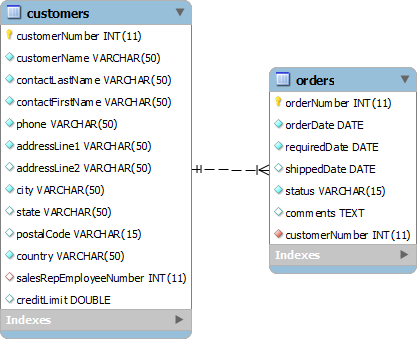Summary: in this tutorial, you will learn about MySQL foreign key and how to create, add, and drop foreign key constraints in MySQL.
Introduction to MySQL foreign key
A foreign key is a field in a table that matches a field of another table. A foreign key places constraints on data in the related tables that, which enables MySQL to maintain referential integrity.
Let’s take a look at the following database diagram in the sample database.

We have two tables: customers and orders. Each customer has zero or more orders and each order belongs to only one customer. The relationship between customers table and orders table is one-to-many, and it is established by a foreign key in the orders table specified by the customerNumber field. The customerNumberfield in the orders table relates to the customerNumber primary key field in customers table.
The customers table is called parent table or referenced table, and the orders table is known as child table or referencing table.
A foreign key has not only one column but also a set of columns. The columns in the child table often refer to the primary key columns in the parent table.
A table may have more than one foreign key, and each foreign key in the child table can have a different parent table.
A row in the child table must contain values that exist in the parent table e.g., each order record in the orders table must have a customerNumber that exists in the customers table. Multiple orders can refer to the same customer therefore this relationship is called one (customer) to many (orders), or one-to-many.
Sometimes, the child and parent table is the same table. The foreign key refers back to the primary key of the table e.g., the following employees table :

The reportTo column is a foreign key that refers to the employeeNumber column which is the primary key of the employees table to reflect the reporting structure between employees i.e., each employee reports to anther employee and an employee can have zero or more direct reports.
The reportTo foreign key is also known as recursive or self-referencing foreign key.
Foreign keys enforce referential integrity that helps you maintain the consistency and integrity of the data automatically. For example, you cannot create an order for a non-existent customer.
In addition, you can set up a cascade on delete action for the customerNumber foreign key so that when you delete a customer in the customers table, all the orders associated with the customer are also deleted. This saves you time and efforts of using multiple DELETE statements or a DELETE JOIN statement.
The same as deletion, you can also define a cascade on update action for the customerNumber foreign key to perform cross-table update without using multiple UPDATE statements or an UPDATE JOIN statement.
In MySQL, the InnoDB storage engine supports foreign keys so that you must create InnoDB tables in order to use foreign key constraints.
MySQL create table foreign key
MySQL create foreign key syntax
The following syntax illustrates how to define a foreign key in a child table in CREATE TABLE statement.
CONSTRAINT constraint_name FOREIGN KEY foreign_key_name (columns) REFERENCES parent_table(columns) ON DELETE action ON UPDATE action
Let’s examine the syntax in greater detail:
The
CONSTRAINTclause allows you to define constraint name for the foreign key constraint. If you omit it, MySQL will generate a name automatically.The
FOREIGN KEYclause specifies the columns in the child table that refer to primary key columns in the parent table. You can put a foreign key name afterFOREIGN KEYclause or leave it to let MySQL to create a name for you. Notice that MySQL automatically creates an index with theforeign_key_namename.The
REFERENCESclause specifies the parent table and its columns to which the columns in the child table refer. The number of columns in child table and parent table specified in theFOREIGN KEYandREFERENCESmust be the same.The
ON DELETEclause allows you to define what happens to the records in the child table when the records in the parent table are deleted. If you omit theON DELETEclause and delete a record in the parent table that has records in the child table refer to, MySQL will reject the deletion. In addition, MySQL also provides you with actions so that you can have other options such as ON DELETE CASCADE that lets MySQL to delete records in the child table that refer to a record in the parent table when the record in the parent table is deleted. If you don’t want the related records in the child table to be deleted, you use theON DELETE SET NULLaction instead. MySQL will set the foreign key column values in the child table toNULLwhen the record in the parent table is deleted, with a condition that the foreign key column in the child table must acceptNULLvalues. Notice that if you useON DELETE NO ACTIONorON DELETE RESTRICTaction, MySQL will reject the deletion.The
ON UPDATEclause enables you to specify what happens to the rows in the child table when rows in the parent table are updated. You can omit theON UPDATEclause to let MySQL to reject any update to the rows in the child table when the rows in the parent table are updated. TheON UPDATE CASCADEaction allows you to perform cross-table update, and theON UPDATE SET NULLaction resets the values in the rows in the child table toNULLvalues when the rows in the parent table are updated. TheON UPDATE NO ACTIONorUPDATE RESTRICTactions reject any updates.
MySQL create table foreign key example
The following example creates a dbdemo database and two tables: categories and products. Each category has one or more products and each product belongs to only one category. The cat_id field in the products table is defined as a foreign key with UPDATE ON CASCADE and DELETE ON RESTRICT actions.
CREATE DATABASE IF NOT EXISTS dbdemo; USE dbdemo; CREATE TABLE categories( cat_id int not null auto_increment primary key, cat_name varchar(255) not null, cat_description text ) ENGINE=InnoDB; CREATE TABLE products( prd_id int not null auto_increment primary key, prd_name varchar(355) not null, prd_price decimal, cat_id int not null, FOREIGN KEY fk_cat(cat_id) REFERENCES categories(cat_id) ON UPDATE CASCADE ON DELETE RESTRICT )ENGINE=InnoDB;
MySQL add foreign key
MySQL add foreign key syntax
To add a foreign key to an existing table, you use the ALTER TABLE statement with the foreign key definition syntax above:
ALTER table_name ADD CONSTRAINT constraint_name FOREIGN KEY foreign_key_name(columns) REFERENCES parent_table(columns) ON DELETE action ON UPDATE action
MySQL add foreign key example
Now, let’s add a new table named vendors and change the products table to include the vendor id field:
USE dbdemo; CREATE TABLE vendors( vdr_id int not null auto_increment primary key, vdr_name varchar(255) )ENGINE=InnoDB; ALTER TABLE products ADD COLUMN vdr_id int not null AFTER cat_id;
To add a foreign key to the products table, you use the following statement:
ALTER TABLE products ADD FOREIGN KEY fk_vendor(vdr_id) REFERENCES vendors(vdr_id) ON DELETE NO ACTION ON UPDATE CASCADE;
Now, the products table has two foreign keys, one refers to the categories table and another refers to the vendors table.
MySQL drop foreign key
You also use the ALTER TABLE statement to drop foreign key as the following statement:
ALTER TABLE table_name DROP FOREIGN KEY constraint_name
In the statement above:
First, you specify the table name from which you want to remove the foreign key.
Second, you put the constraint name after the
DROP FOREIGN KEYclause.
Notice that constraint_name is the name of the constraint specified when you created or added the foreign key to the table. If you omit it, MySQL generates a constraint name for you.
To obtain the generated constraint name of a table, you use the SHOW CREATE TABLE statement as follows:
SHOW CREATE TABLE table_name
For example, to see the foreign keys of the products table, you use the following statement:
SHOW CREATE TABLE products
The following is the output of the statement:
CREATE TABLE products ( prd_id int(11) NOT NULL AUTO_INCREMENT, prd_name varchar(355) NOT NULL, prd_price decimal(10,0) DEFAULT NULL, cat_id int(11) NOT NULL, vdr_id int(11) NOT NULL, PRIMARY KEY (prd_id), KEY fk_cat (cat_id), KEY fk_vendor(vdr_id), CONSTRAINT products_ibfk_2 FOREIGN KEY (vdr_id) REFERENCES vendors (vdr_id) ON DELETE NO ACTION ON UPDATE CASCADE, CONSTRAINT products_ibfk_1 FOREIGN KEY (cat_id) REFERENCES categories (cat_id) ON UPDATE CASCADE ) ENGINE=InnoDB;
The products table has two foreign key constraints: products_ibfk_1 and products_ibfk_2.
You can drop the foreign keys of the products table by using the following statement:
ALTER TABLE products DROP FOREIGN KEY products_ibfk_1; ALTER TABLE products DROP FOREIGN KEY products_ibfk_2;
MySQL disable foreign key checks
Sometimes, it is very useful to disable foreign key checks e.g., when you load data into the tables that have foreign keys. If you don’t disable foreign key checks, you have to load data into a proper order i.e., you have to load data into parent tables first and then child tables, which can be tedious. However if you disable the foreign key checks, you can load data into any orders.
Another example is that, unless you disable the foreign key checks, you cannot drop a table that is referenced by a foreign key constraint. When you drop a table, any constraints that you defined for the table are also removed.
To disable foreign key checks, you use the following statement:
SET foreign_key_checks = 0
And of course, you can enable it by using the statement below:
SET foreign_key_checks = 1
In this tutorial, we have covered a lot about MySQL foreign key. We also introduced you to some very handy statements that allow you to manage foreign keys effectively in MySQL.

 随时随地看视频
随时随地看视频




